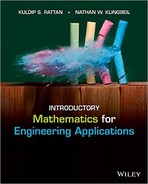Preface |
This book is intended to provide first-year engineering students with a comprehensive introduction to the application of mathematics in engineering. This includes math topics ranging from precalculus and trigonometry through calculus and differential equations, with all topics set in the context of an engineering application. Specific math topics include linear and quadratic equations, trigonometry, 2-D vectors, complex numbers, sinusoids and harmonic signals, systems of equations and matrices, derivatives, integrals, and differential equations. However, these topics are covered only to the extent that they are actually used in core first- and second-year engineering courses, including physics, statics, dynamics, strength of materials, and electric circuits, with occasional applications from upper-division courses. Additional motivation is provided by a wide range of worked examples and homework problems representing a variety of popular engineering disciplines.
While this book provides a comprehensive introduction to both the math topics and their engineering applications, it provides comprehensive coverage of neither. As such, it is not intended to be a replacement for any traditional math or engineering textbook. It is more like an advertisement or movie trailer. Indeed, everything covered in this book will be covered again in either an engineering or mathematics classroom. This gives the instructor an enormous amount of freedom – the freedom to integrate math and physics by immersion. The freedom to leverage student intuition, and to introduce new physical contexts for math without the constraint of prerequisite knowledge. The freedom to let the physics help explain the math and the math to help explain the physics. The freedom to teach math to engineers the way it really ought to be taught – within a context, and for a reason.
Ideally, this book would serve as the primary text for a first-year engineering mathematics course, which would replace traditional math prerequisite requirements for core sophomore-level engineering courses. This would allow students to advance through the first two years of their chosen degree programs without first completing the required calculus sequence. Such is the approach adopted by Wright State University and a growing number of institutions across the country, which are now enjoying significant increases not only in engineering student retention but also in engineering student performance in their first required calculus course.
Alternatively, this book would make an ideal reference for any freshman engineering program. Its organization is highly compartmentalized, which allows instructors to pick and choose which math topics and engineering applications to cover. Thus, any institution wishing to increase engineering student preparation and motivation for the required calculus sequence could easily integrate selected topics into an existing freshman engineering course without having to find room in the curriculum for additional credit hours. Finally, this book would provide an outstanding resource for nontraditional students returning to school from the workplace, for students who are undecided or are considering a switch to engineering from another major, for math and science teachers or education majors seeking physical contexts for their students, or for upper-level high school students who are thinking about studying engineering in college. For all of these students, this book represents a one-stop shop for how math is really used in engineering.
